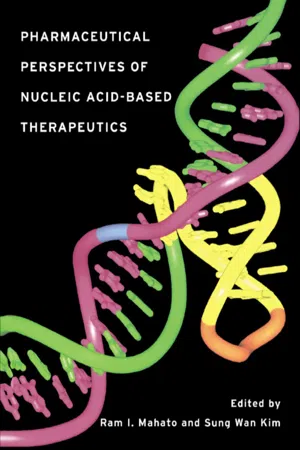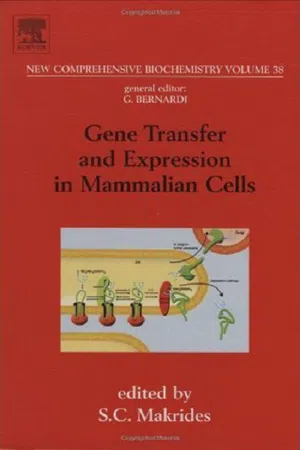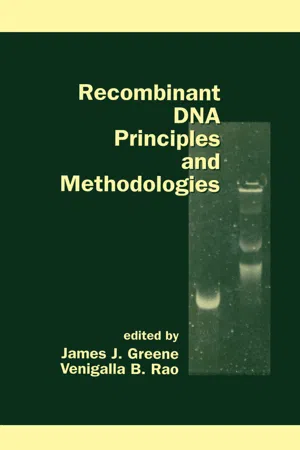Biological Sciences
Expression Vector
An expression vector is a type of DNA molecule used to introduce a specific gene into a target organism for the purpose of expressing the gene and producing its corresponding protein. These vectors typically contain regulatory elements that control the expression of the gene, as well as selectable markers for identifying cells that have successfully taken up the vector.
Written by Perlego with AI-assistance
Related key terms
Related key terms
1 of 4
Related key terms
1 of 3
3 Key excerpts on "Expression Vector"
- Ram I. Mahato, Sung Wan Kim(Authors)
- 2002(Publication Date)
- CRC Press(Publisher)
1Basic components of gene expression plasmids
Jun-ichi MiyazakiINTRODUCTION
Various plasmid vectors, including expression units for mammalian cells, have been developed for various purposes: to produce valuable proteins, to characterize gene products, to analyze the physiological consequences of overexpressing foreign genes, or to isolate genes of interest by screening recipient cells. Recently, plasmid vectors have also been used for nonviral gene therapy, owing to the development of novel gene delivery methods, such as naked DNA injection, in vivo electroporation, and lipofection. Various modifications have been added to optimize the preexisting plasmid vectors for such in vivo use, although the basic structure of the expression plasmid vectors remains unchanged. In this chapter, an overview of the essential elements of expression plasmid vectors from the viewpoint of their in vivo use will be given.ESSENTIAL ELEMENTS OF EXPRESSION PLASMID VECTORS
In general, expression plasmid vectors are based on prokaryotic episomal plasmids, which are combined with eukaryotic gene transcription elements (Figure 1.1 ). Plasmid vectors always contain an origin of replication (ori) and a selection marker. These constituents are required for the selection and amplification of plasmidcontaining bacterial cells, usually Escherichia coli. The selection marker is commonly a gene that confers resistance to some antibiotic, such as ampicillin, kanamycin, or tetracycline; of these, the ampicillin resistance gene is the most widely used. The eukaryotic part contains a single or multiple expression unit consisting of a transcriptional initiation element (enhancer/promoter), a multiple cloning site (MCS), and a sequence allowing for transcription termination. In most cases, the DNA inserted into the MCS for expression is not a genomic gene from the original exon/intron configuration, but a cDNA lacking introns. However, most expression plasmids contain an intron with splice consensus sequences 5′ or 3′ from the multiple cloning site. Apart from these basic elements, some expression plasmids contain additional elements that facilitate replication in mammalian cells. Expression plasmids for in vitro- eBook - ePub
- S.C. Makrides(Author)
- 2003(Publication Date)
- Elsevier Science(Publisher)
12 ]. This approach exploits the cell-targeting specificity of viruses without the disadvantages of virus-based vectors.4 Genetic elements of mammalian Expression Vectors
Vectors for protein production in mammalian cells comprise a variety of genetic elements with distinct functionalities (Fig. 1 ): (1) a constitutive or inducible promoter that is capable of robust transcriptional activity; (2) a transcription terminator that stabilizes the transcript and prevents transcription interference; (3) optimized mRNA processing and translational signals that include the Kozak sequence, translation termination codon, mRNA cleavage and polyadenylation signals, as well as mRNA splicing signals for higher levels of expression; (4) prokaryotic origin of replication and selection marker for vector propagation in bacteria; and (5) selection markers for the preparation of stable cell lines and for gene amplification. The inclusion of the SV40 origin of replication facilitates transient gene expression in COS cells. Other genetic elements for specific applications include sequences for gene or protein targeting, signal peptides for protein secretion, fusion moieties and protease cleavage sites (see Section 6 ), and ribosome- or protease-recognition sites that facilitate the expression of multiple genes from polycistronic (Fig. 1 C) or monocistronic (Fig. 1 D) constructs, respectively (see Section 8 ). An extensive list of mammalian Expression Vectors has been published [1 ].Fig. 1 Configuration of model genetic elements in mammalian Expression Vectors. The combination of different elements (not drawn to scale) may vary in order to meet specific objectives. SV40 ori facilitates transient gene expression in COS cells. Promoters (P) facilitate constitutive (A) or inducible (B) expression. The optimal translational initiation sequence (Kozak) and termination tetranucleotide are shown. The ColE1 origin and the Ampr gene allow plasmid replication and selection, respectively, in bacteria. The Neor gene facilitates selection, and the dhfr gene allows both selection and gene amplification in cells. Multiple gene expression utilizes polycistronic constructs (C) where IRES elements enable ORFs to be translated from a single transcript (see Section 8 ). Alternatively, a monocistronic construct (D) contains in-frame cDNAs joined by linkers encoding recognition sites (Arg-X-Arg/Lys-Arg) for the endoprotease furin, thus facilitating the post-synthetic cleavage of different proteins (see Section 8 ). Abbreviations : Ampr , ampicillin-resistance gene (β-lactamase); ColE1, prokaryotic origin of replication; dhfr, dihydrofolate reductase (methotrexate resistance); F, furin-recognition sequence; FUS, fusion moiety; hCMV-IE, human cytomegalovirus immediate early enhancer/promoter; IRES, internal ribosome entry site; L, leader (targeting sequence); MCS, multiple cloning site; Neor , neomycin-resistance gene (aminoglycoside phosphotransferase, aph - eBook - ePub
- James Greene(Author)
- 2021(Publication Date)
- CRC Press(Publisher)
E. coli and are presently available for clinical use. Yet the intrinsic limitations of prokaryotic expression systems noted above clearly demonstrate the need for mammalian vectors to permit expression of cloned mammalian genes in their natural environment. This also provides an approach for probing some of the fundamental aspects of eukaryotic transcription, posttranscription, and translational control mechanisms. In addition to providing experimental model systems to increase our understanding of some fundamental biological processes, these vectors are also currently being used in clinical applications such as molecular treatment of diseases and human gene therapy (Anderson 1984, 1992; Crystal 1995; Mulligan 1993).The introduction of exogenous DNA into mammalian cells has now become an integral part of many experimental protocols investigating the expression of genes, their regulation, and the impact of their expression on the cellular phenotype. The three major phases of this approach are delivery of DNA into cells, identification of cells that have received the DNA, and expression of the exogenous DNA. This review will concentrate on mammalian expression systems constructed in plasmid vectors that are used to transfer cloned DNA sequences into mammalian cells, and the methods frequently used to deliver these vectors to mammalian cells in culture.II. DELIVERY OF DNA INTO CELLS
Several techniques including chemical, physical, fusion, and viral means can potentiate the delivery of DNA into cultured cells. In all cases the DNA must ultimately enter the nucleus to be expressed. The choice of method for DNA delivery depends on several factors including the level of gene expression desired, whether short-term or long-term expression is needed, whether the cells are primary cultures or established, and whether they “grow” in suspension or are adherent cultures. Detailed protocols for all of these methods, except microinjection, are available in an increasing number of “how-to” books and are not presented here (Janssen 1994; Kriegler 1990; Murray 1991). Many of the necessary reagents for transfection and lipofection that are commercially available and not prohibitively expensive arrive with detailed protocols. While electroporation is expensive because of the initial cost of a commercial electroporator, detailed information on how to use it comes with the instrument. All methods must be optimized for the recipient cells being used and the DNA being transferred, so most protocols provided are generic.
Index pages curate the most relevant extracts from our library of academic textbooks. They’ve been created using an in-house natural language model (NLM), each adding context and meaning to key research topics.
Explore more topic indexes
Explore more topic indexes
1 of 6
Explore more topic indexes
1 of 4


